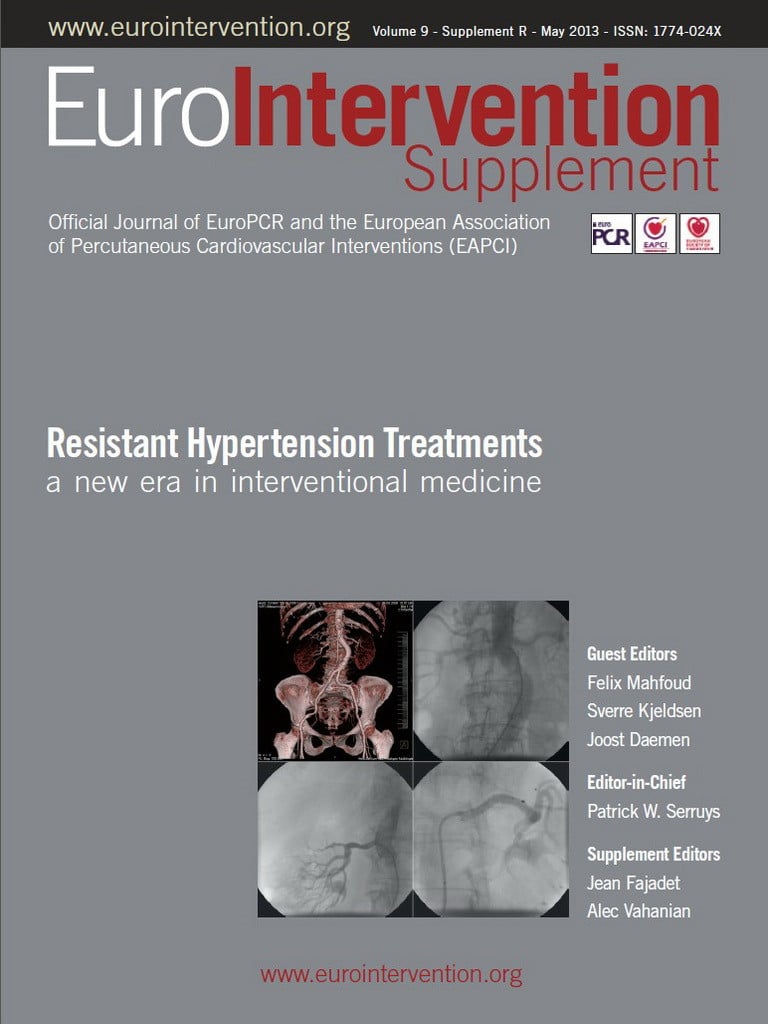Approximately 10% of all patients treated for hypertension remain with uncontrolled high blood pressure (BP) despite the prescription of antihypertensive drugs1. Renal sympathetic denervation was introduced as a new treatment of hypertension that was apparently resistant to drug treatment in the Symplicity HTN-2 study2: 106 patients were randomised to renal sympathetic denervation or control, and office BPs were reduced by 32/12 mmHg in the intervention group at six months, while remained unchanged in the control group. Renal sympathetic denervation has created worldwide enthusiasm and sparked the interest in the care of the most difficult hypertensive patients. This is good news for patients, for physicians, for industry developing new equipment and devices, for researchers who now see an entire new field opening, for meetings and congresses such as the inaugural Resistant Hypertension Course (www.resistanthypertensioncourse.com) in Berlin this year - and on which this supplement is partly founded - and for communities that hopefully will see less hypertensive complications such as strokes, heart attacks and renal failure.
Not all patients will respond with BP reduction after renal sympathetic denervation. Thousands of patients have undergone the procedure, performed by hundreds of trained physicians, and dozens of commercial companies are competing to develop the most advanced devices to perform successful procedures. The time has come to reconsider and reflect on the pitfalls, as well as the lack of knowledge that is characterising, not least, the various aspects of patient selection and handling for renal sympathetic denervation. Furthermore, there is a need to clarify the varying response to the procedure in different patients and thereby avoid redundant interventions. We must also consider the potential benefits such as organ protection, and the effect on morbidity and mortality. In the hitherto only randomised prospective and controlled Symplicity HTN-2 study2, there was little emphasis on ambulatory BP measurements, which might have revealed whether the “white coat” effect could mask the true benefit of renal denervation. Furthermore, and even more importantly, drug adherence was not thoroughly investigated in the Symplicity HTN-2 study2.
It has, in fact, been known for decades that poor drug adherence is a major problem among patients with apparent treatment resistant hypertension3,4. It is unknown to what degree the decline in BP following renal denervation2 is caused by denervation itself or concomitantly improved drug adherence. Recently, in a study of 84 patients taking, on average, five antihypertensive drugs, it was shown by measurements that no drug was detectable in the blood of 34.5% of these patients, and 65.5% fulfilled the criteria of non-adherence5. Neither improved drug adherence nor self-prescribed reduction in antihypertensive drug regimen could be detected in Symplicity HTN-22, and this was the motivation for the sham procedure in the ongoing Symplicity HTN-3 study in the USA6. In the midst of enthusiastic reports of successful BP reductions following renal denervation there are also investigators who report lower BP responses7.
Drug adherences may be investigated by electronic pill boxes, blood and urine measurements of prescribed drugs or written patient diaries. However, the only method that ensures 100% true drug intake is that it be witnessed. Measurements of drugs, if feasible, can provide interesting information5, but often too late in practical clinical work. Neither a patient’s diary, as was used in Symplicity HTN-22, nor electronic pill boxes are reliable to ensure drug intake. It is well known that participating in a study and regular controls can improve the prognosis, and this is explained at least in part by better BP control due to improved drug adherence. Our preliminary findings in a strictly standardised protocol showed that only six of 18 patients qualified for renal sympathetic nerve ablation procedure. The other patients could not be included for various reasons or because ambulatory BP was lowered below the limit for inclusion after witnessed intake of their BP medication. The fact that a minority of apparently treatment resistant hypertensive patients are eligible for renal denervation has also been shown on a much larger scale8.
In the Oslo RDN Randomised Study (ClinTrialGov ID: NCT01673516) the process of randomising patients with true treatment resistant hypertension is currently ongoing in a similar protocol as in Symplicity HTN-3, i.e., renal denervation with the Symplicity™ Catheter System vs. intensified drug treatment guided by noninvasive haemodynamic assessments using impedance cardiography9. Yet another novel aspect of the Oslo RDN study is that patients can only qualify if ambulatory BP remains elevated after witnessed intake of the antihypertensive drugs.
The effect of renal denervation on heart rate is also interesting10. In fact, we, like many other centres that are currently doing renal denervation in prospective protocol-defined studies with regulatory approval, are paying special attention to heart rate variability in order to detect possible a priori responders to the procedure. We have previously investigated the reproducibility of 24-hour BP in patients with newly diagnosed hypertension and reproducibility is reasonably high11. We believe that we can exclude spurious hypertension and poor drug compliance with rather high precision with one qualifying measurement of ambulatory BP after witnessed drug intake prior to renal denervation.
Our hypothesis, that the blood pressure decrease observed in previous cohorts is partly explained by increased drug adherence, remains currently speculative and may even be counter-intuitive and at odds with observations of patients stopping their drugs after renal denervation. Further, the blood pressure response after renal denervation in patients with poor drug adherence is unknown until more specifically investigated. However, in many hypertensive patients characterised as treatment resistant to drug therapy, identification of poor drug adherence is critical in order to identify and predict who the true responders to renal sympathetic denervation are.
Conflict of interest statement
S. E. Kjeldsen has received lecture honoraria from AZ, Bayer, Medtronic, MSD and Takeda, honoraria for consulting from Bayer, Medtronic, Takeda and Serodeus, and research support from AZ and Pronova. I. Os reports no conflict of interest. F. Mahfoud has received scientific support from Medtronic, St. Jude, Vessix, and Recor, lecture honoraria from Medtronic, St. Jude, Cordis, Takeda, Boehringer Ingelheim and Novartis.

